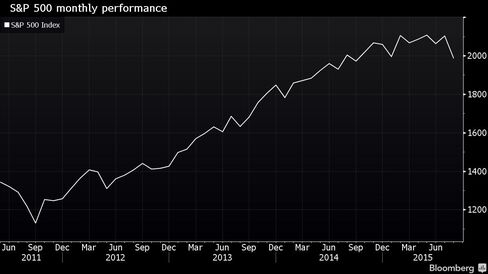U.S. stocks fluctuated, with the Standard & Poor’s 500 Index on track for its worst month since May 2012, as equities continued to swing amid this week’s volatile trading and shifting investor sentiment.
Google Inc. fell 1.3 percent and Apple Inc. slipped to weigh on technology shares in the benchmark index. Wal-Mart Stores Inc. lost 1.8 percent amid a weaker consumer confidence reading. Energy companies advanced as oil added to yesterday’s best rally in six years. Chevron Corp. rose 3.3 percent, to bring its three-day climb to 14 percent. Freeport-McMoRan Inc. gained 2 percent after Carl Icahn took a stake in the copper producer.
The S&P 500 slid 0.1 percent to 1,985.43 at 11:05 a.m. in New York, after earlier falling as much as 0.5 percent before erasing its decline amid another bout of volatility. The Dow Jones Industrial Average slipped 41.33 points, or 0.3 percent, to 16,613.44. The Nasdaq Composite Index was little changed.

S&P 500 on track for its worst month since 2012
“We’re not done with all the volatility in equities,” said Andrew Brenner, the head of international fixed income for National Alliance Capital Markets. “The Dow gave back a 300 point gain and then ended up more than 300 yesterday so it’s hard to say how today will be judged. I think the worst is over, but are we out of the woods yet? No -- we’re still going to have a lot of volatility.”
The Chicago Board Options Exchange Volatility Index rose 2.2 percent to 26.68 Friday, rising for the first time in four sessions. The measure of market turbulence known as the VIX fell 36 percent in the prior three days, after a record six-day jump sent the gauge to its highest level since October 2011.
The S&P 500 yesterday capped its best two-day rally since the beginning of the bull market in 2009, helped by data showing stronger-than-expected U.S. economic growth. The Dow had its strongest back-to-back advance since December 2008. Global equities had lost as much as $8.4 trillion in value after China’s unexpected devaluation of the yuan earlier this month spurred concern the world’s second-biggest economy was on the brink of a deeper slowdown. The S&P 500 closed Thursday down 5.5 percent in August.
Data today showed consumer spending climbed in July as incomes grew, showing the biggest part of the U.S. economy was off to a good start to the quarter. The 0.3 percent advance matched the prior month’s gain, according to the Commerce Department. The median forecast in a Bloomberg survey of economists called for a 0.4 percent increase. Wages rose by the most this year, and the report showed inflation remained tame.
A separate report showed consumer confidence declined in August to a three-month low as recent stock-market turbulence weighed on Americans’ outlook for the U.S. economy in the coming year.

S&P 500 whipsawed by gains and losses this week
Inflation is the theme at an annual symposium in Jackson Hole, Wyoming this week where Federal Reserve officials and economists have also been discussing market fallout from China’s slowdown that has cast doubt on whether the Fed will raise rates next month. Traders are now pricing in a 30 percent chance the central bank will act in September, down from almost even odds before China’s surprise move to devalue its currency earlier this month.
St. Louis Fed Bank President James Bullard said in a Bloomberg Television interview Friday that while world financial markets are volatile, U.S. fundamentals are good and the interest rate-setting Federal Open Market Committee shouldn’t alter its forecast for the economy.
source:Bloomberg
No comments:
Post a Comment